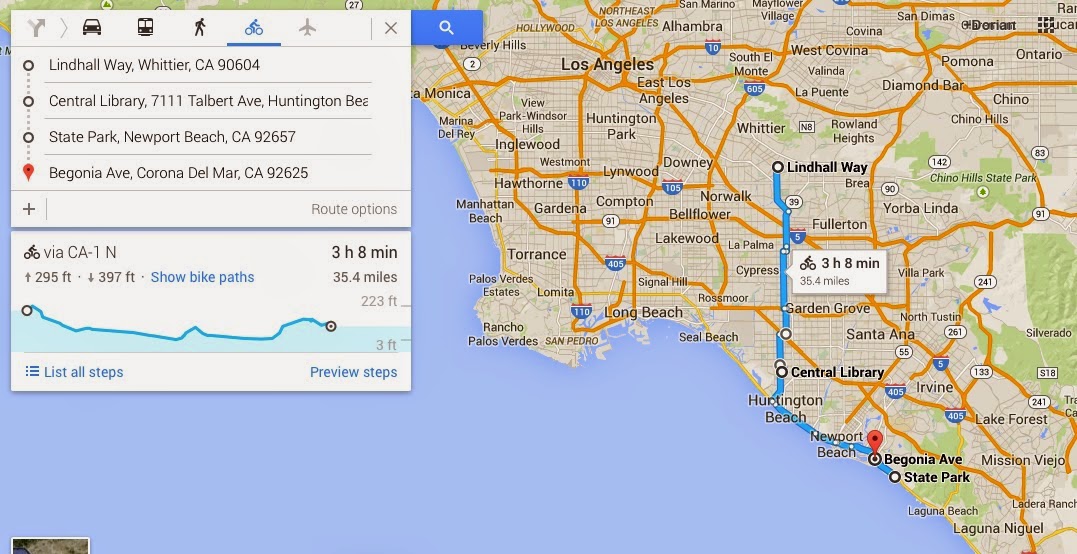I arrived at the Huntington Beach Public Library mid-afternoon. I had been directed by many birders to search the reeds around any of the small ponds (either full or dry) found in this vicinity. My search of the dry pond north of the library was unsuccessful. I did, however, observe an Orange bishop as it flew past me and into the reeds. This is another introduced species that will at some point become countable. Crossing the street, I found a full pond, ducks and grebes included, with some patches of attractive reeds surrounding it. A quick pish brought 2 munias into view for year bird #575. I managed to get a decent photo of one of them. Sitting on a nearby bench to enjoy my victory sandwich, I spotted at least a dozen more munias as they came and went from the reeds. The search turned out to be fairly straight-forward and left me with a relaxing afternoon ride down to Newport Beach where I would spend the night.
36 miles after a bit of messing around in the parks
Munia habitat
Scaly-breasted munia for #575
The ride to Newport was really relaxing and easy. I arrived at around 4:30, yakked with my hostess for a bit, and then decide to head down the coast a few miles to Crystal Cove State Park to see if I could find California gnatcatcher. I had no idea what to expect, but I figured if nothing else I could get a lay of the land so that when I passed through here tomorrow morning on my way south I would have a plan of attack to bird the area. I rolled in, locked up the bike, and started to walk down what looked like a well-used running path. I hadn't walked 20 yards before I heard the characteristic "meeeeewwwww-ing" of the gnatcatcher. I easily located it just off the running path for #576. This bird was backlit, but several others were calling a bit further down the path. I was able to obtain what I think is s very nice photo of one of them! This bird has suffered big declines as development in Southern California has progressed (Ugh). For a very short snippet about the status of this bird, check this out.
Gnatcatcher habitat - multi-million
dollar Laguna homes on hill in back
California thrasher, cuz why not?
OK, now for a bit of rumination. Several people have asked me if I use eBird this year. The answer is yes and no. My big year is focused very squarely on finding as many regularly occurring species as possible; I cannot chase rarities more than ~50 miles from me. It is in finding productive spots to search for breeding or very regularly occurring species that eBird particularly excels. This is because there are generally lots of data points for regularly occurring species, and the particular clustering of these points helps me select in which areas to look for which birds. eBird is not terribly helpful for rarities since they are rare and represented by very few data points. Trying to find a good spot in the lower 48 for Broad-billed sandpiper? Good luck...there's only one data point (Jamaica Bay, NY, 1998 - I saw it!). The more data points that exist for a particular species, the more useful eBird becomes in locating it. I have utilized eBird A TON this year since 95% of my searches are for birds that, by birding standards, would be considered fairly common.
Now, I will confess that I have never eBirded a single bird in my life. There are two very good explanations for this. In my former life, I was a scientist of a very serious caliper. My life revolved around formulating hypotheses, designing experiments, and analyzing data to probe various mechanisms of cellular function. As my life revolved around data, the last thing I wanted to do when I was in the field was collect data on birds. I did not want birding to feel at all like my science. It was a break from science, and for me that was really important. As for this year, I have elected to put my efforts into the blog versus eBird. This is a personal decision that I do not at all regret. Looking back in 20 years, eBird checklist won't mean a thing to me compared to words I have penned.
All of this being said, I do plan to eBird in the future. First, my professional life is unlikely to revolved around data collection and analysis moving forward. Second, and more importantly, my bird data is valuable, and as such I should enter it into eBird. I am a decent birder who has utilized the resource, and I should make at least some form of contribution moving forward. Some people really like making checklists for every single birding stop they make. They can get obsessive about it, and that's fine. I obsess A LOT about my photography, so I know how it is. Just know that there's not a chance in hell I'll ever be a top eBirder since my focus is normally on photograph anyway!
Tomorrow I will cruise south to San Diego, my "home" for the next 5-6 days! This should be an exciting leg!







Here in India, they appear during the monsoon and dissapear after that.
ReplyDelete